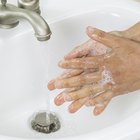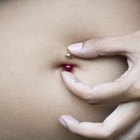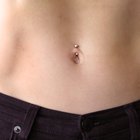
Getting your ears pierced can be a fun and exciting endeavor. Piercings are popular and easy to obtain. However, the Mayo Clinic recommends doing some research before the event as piercings can carry complications. It is important to research where you get your ears pierced as well as how to care for your new piercing to help speed up the healing process.
Where to Get the Piercing
The Mayo Clinic recommends getting your ear piercing at a reputable piercing studio where its employees are properly trained. There are different piercing-related regulations for each state; however, you want to make sure that the operator is following proper sterile techniques to prevent infection and the spread of disease.
When choosing where to get your ears pierced, the Mayo Clinic suggests making sure whoever is piercing your ears wears gloves, uses the proper equipment, and sterilizes non-disposable equipment. According to AAFP.com, you should never perform the piercing yourself as it increases the risk of infection.
Hypoallergenic Jewelry
The Mayo Clinic recommends using hypoallergenic materials for the piercing-inserted earrings, such as surgical-grade steel, titanium, or 14-karat gold. Using hypoallergenic jewelry will limit the possibility of an allergic reaction to the earring.
Caring for Your New Piercing
Clean your ear piercings twice a day with antibacterial soap, twisting the earring as you clean. This will prevent the earring from sticking to the inside of the hole. You can remove any crusting you may have with a cotton-topped swab. It is important to wash your hands before cleaning your piercing. Don't touch the piercing unless you are cleaning it. Avoid putting peroxide or alcohol on your piercing as these liquids both dry out the skin. Ointments inhibit the flow of oxygen to the piercing and should be avoided as well.
The Mayo Clinic recommends leaving earrings in place for at least six weeks after the piercing, with other body piercings possibly taking longer to heal. It is recommended that you leave the piercing in place to prevent the new hole from closing. Once the piercing heals, you can switch the earrings out. You can tell if your piercing is healed if it is no longer weeping fluid, there is no more redness, and it doesn't hurt to take your earring in and out.
Complications
According to AAFP.org, infections such as HIV and hepatitis can be spread by body piercing if the instruments are contaminated with blood, or are not sterilized properly in-between clients. This is why it is so important to research the facility you plan to use to get your piercing done. Other possible complications that may occur include bleeding, swelling, scarring, and an allergic reaction to the jewelry.
Signs of Infection
If your piercing is infected, the skin around the piercing may be red and inflammed, and may be sensitive to the touch. Also, there may be yellowish, foul-smelling fluid oozing from the piercing. If you have any of these symptoms accompanied by a fever, AAFP.org recommends seeing your doctor immediately.
Related Articles

How to Use Colloidal Silver to Kill ...

Care for Pierced Ears with Isopropyl ...

How to Drain a Cheek Piercing

Homemade Recipe to Disinfect a Piercing

How to Stop a New Piercing From Itching

How to Get a Guiche Piercing

How to Pierce Your Navel

How to Change Pierced Earrings

How to Take Out a Silver Hoop Belly ...

What Is Bio-Flex Made of for Piercings?

How Is Nipple Piercing Performed?

What to Do When a Nose Ring Falls Out

Nipple-Piercing Risks

Professional Way to Clean an Eyebrow ...

How to Take Care of an Eyebrow Piercing

How to Open Pierced Ears That Have ...

How to Care for a Rook Piercing

How to Prepare for a Nose Piercing

How to Stop Pierced Ears From Seeping

How to Remove a Navel Piercing
References
Writer Bio
Nicole Michelle has been writing professionally since 1998. She is also a certified personal trainer who writes a monthly newsletter for the men and women who participate in her boot camp, giving diet and exercise information to help her students succeed. Michelle is pursuing a Bachelor of Arts in psychology at California State University Channel Islands.
Photo Credits
earing image by arkna from Fotolia.com